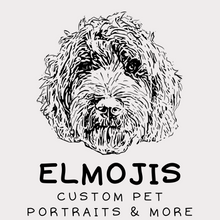Have you always been curious how the beautiful digital portraits and designs we create end up on the product? Are you getting confused with all the technical abbreviations around digital printing? We got you covered by explaining the various digital printing processes we use at Elmojis below.
We want to make our creations as pretty as possible by choosing techniques that will enhance them so let's take a look at what techniques are used by our printer for which products:
DTG for clothing
Most of our textile products (clothing, tote bags, etc.) are printed using a digital printing system called DTG, which stands for Direct To Garment.
DTG first emerged in 2005, but it has taken a good few years to make it viable for current production methods. It is still quite rare in the market, and we are delighted to have found a printing partner who is providing this service. However, it requires a very precise and complex manual process.
How does it work?

The textile is placed on a tray, then after transferring the design to the printer, the printer sprays the various water-based inks (environmentally friendly and vegan) on the surface of the textile. In order to dry and fix this ink within the mesh, the textile is passed through a drying tunnel (think of it as a giant oven with a conveyor belt).
What are the advantages of DTG?
Plenty. There are plenty of advantages.
First there is flexibility of the process: it serves the production of a single T-shirt or an order of 100 pieces. Also, DTG is an extremely fast process: the transition from print file to finished product is almost immediate. And no, it's not magic... It's DTG.
In addition to being eco-responsible thanks to the possibility of using environmentally friendly water-based inks, this method proves to be the opposite of mass production as it can be used to print your unique custom pet portrait.
Another important advantage is the print quality : it's simple, the rendering is as precise as a classic paper printer. The printed result will be very close to the original design. The "hand" (i.e. the touch of the textile) is fantastic and is almost imperceptible.
Dye sublimation printing for other materials
Mugs, water bottles, and pouches are printed with dye sublimation printers.
What does this mean?
Technically, when the ink pigment is heated to almost 200°, it changes from a solid to a gas.
The design is printed on a suitable support, then applied to the product to be marked. A heat press or a tunnel will finally allow the ink to react on the object, and to fix it completely in it.
Note that in order to transfer the image onto the object, it must be coated with a specific coating to be able to be sublimated: in short, a classic white mug from the shops will not be sublimable.

What are the benefits?
First of all, the process ensures that the printed product is incredibly resistant to wear and tear: in other words, the visuals are "integrated" into the product for an indefinite period. Washing, repeated use,... nothing can alter our work. This is an excellent printing solution that fits perfectly with our ambition to participate in a more sustainable mode of consumption.
Secondly, they come out of the print particularly bright, which makes for an exceptional aesthetic.
So, what are you still waiting for? Still undecided which product to choose? Drop us a note or contact us via chat and we will be happy to assist you!

